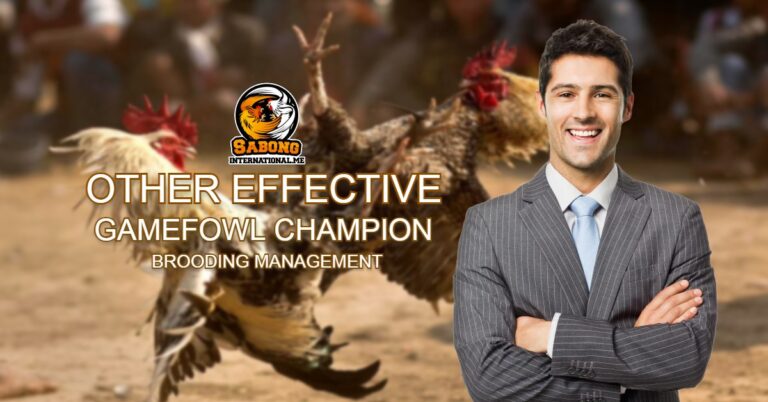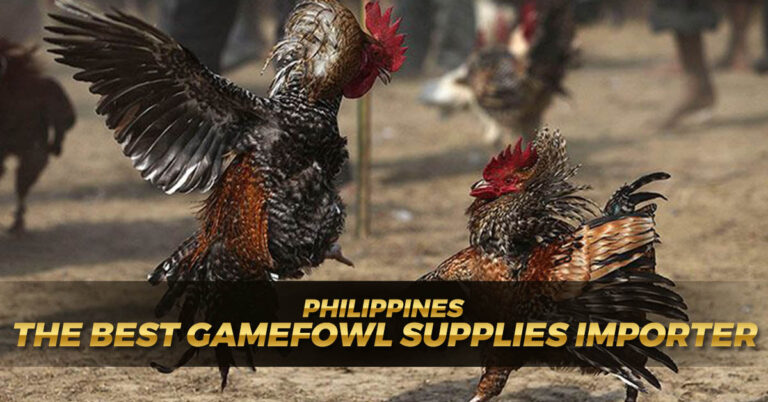Learn Different Kinds of feeds for the Best Gamefowl Performance
Sabong International provides you the foundation of producing winning fighting cocks, according to a good and ethical gamefowl breeder, choosing the right feeds, particularly during the KEEP or conditioning stage, when a gamefowl’s optimum nutrition is essential for improved performance.
Always feeding is the key to the KEEP. When compared to off-season and breeding season feeding, feeding occurs throughout the KEEP at a completely different time. Your cock’s capacity to reach peak fighting form just in time for a derby bout is maximized by the meal mixture, which is specifically created for this purpose.

Starter Gamefowl Feeds
According to a fundamental theory, protein builds and repairs the muscles of game birds. And as that muscle grows, the battlecock gains more strength.
For the appropriately pre-conned gamecocks, the feed’s crude protein content should be between 17 and 19 percent. If you still wish to condition those that are not preconditioned, you could even need to feed your rooster up to 22% crude protein to maintain muscle growth and repair over a shorter period of time.
For a more knowledgeable enthusiast, we suggest approaching this through the diet and supplements amino acid makeup. Even if your diet contains 18% crude protein, you still could not be getting enough of the amino acids that give your muscles their main strength. But, as this is a more complex subject, we will address it in another essay.
The Composition of the Feed (Ingredients)

Conditioning Gamefowl Feeds
Conditioning Gamefowl feeds are created to supplement the other nutrition that the grains are deficient in for the conditioning activities. In order to elevate the amounts to at least the minimum level required by the gamefowl during the conditioning stage, conditioning gamefowl feeds are fortified with more calcium, other vitamins, and minerals, as well as higher crude protein (20 to 22 percent). Normally 30% to 40% of the whole diet is consumed.
In order to avoid the detrimental effects of phytic acid on muscular contraction, conditioning pellets frequently include Phytic Acid Neutralizer (PAN).
Vegetarian proteins: Important Supplement
To increase the protein content of the gamefowls’ diet, animal proteins are added. also includes any vitamins and minerals that are present in the specific animal protein.
Due to their involvement in the conditioning process, you must provide them with some protein supplements. When tissues are damaged, they need to be recreated and healed. increasing muscle mass and density. You must add animal proteins as a supplement to them in order to achieve this. Animal protein has more critical amino acids for building muscular tissues than its counterpart from a vegetarian source.
Egg White: Important Protein Supplement
Provides no cholesterol or fat, which helps build lean muscle. Yet, adding (and balancing) moisture to the meal is egg white’s primary function. It’s because egg white only contains a small number of amino acids despite having a high crude protein content.
The anti-nutrient issue with egg white must be resolved by cooking it or at least subjecting it to some sort of heat treatment; if consumed raw, egg white is useless. Egg yolk is typically fed to game birds that are not yet in the conditioning stage.
Beef: High-Quality Protein Supplement
Compared to pork and egg white, beef has more crude protein. Also, it is rich in amino acids, especially those that gamefowl need to develop their first few buckles (Phosphagen System). Learn more about the Phosphagen System.
Beef is at its greatest in the final three days before the fight, whereas beef liver is excellent throughout precon and training.

Milk: Providing Gamefowl with Moisture
The issue is that because they are not mammals and lack the enzyme lactase, which breaks down lactose into glucose and galactose, chickens cannot digest these sugars. This means that the energy is neither absorbed nor assimilated. Unaware of the fact, many people use fresh or powdered milk, but the sole advantage of their milk is that it provides moisture for the hens.
If you want to make the lactose in fresh milk simpler so that game birds can digest it, you may ferment it. In our recipe, we combine a pure culture of lactic acid bacteria with 12 parts of fresh milk.
Remove any other acidic supplements you may be adding because this is now somewhat more acidic than raw milk. Prior to the chicken being able to handle them, these may cause (occasionally) gastrointestinal pain.
Others
If you’re on a tight budget, like the typical mountain farmers who asked us what to substitute for the meat, we recommend looking for readily available protein sources like frogs, hornets, or wasp larvae. They considerably outperform their competitors in their lowly competition (tupada) on the highlands because of this straightforward addition to their meals.
Processing of Gamefowl Feeds
Providing the proper food is insufficient. The ability of the gamefowl breed to efficiently absorb the nutrients from the diet is also necessary. Processing of feed is needed in this situation. Four feed processing techniques can help gamefowl absorb nutrients more efficiently: soaking, fermenting, germination, and boiling. We’ll also talk about how important grits are for processing bird feed.
Soaking: Removing Dangerous Substances and Increasing Protein Assimilation
Phytic acid and other harmful substances can be removed from the grains by soaking them beforehand. Ineffective power and extension can be the result of phytic acid weakening muscular contraction. The amount of phytic acid in the grains can be greatly reduced or even eliminated by soaking.
The ability of grains to absorb protein from legumes including beans, peas, lupins, and tapilans is another benefit of soaking grains. Compared to chickens fed dry grains, soaking grains can increase protein absorption by 30%. Typically, from 7:00 am to 3:30 pm, the grains are soaked for 7 to 12 hours, after which they are drained and washed. Then, from 4:30 pm till 7:00 am the next morning, a fresh batch is steeped. The process of soaking goes on.
Fermentation: Improves Fiber Digestibility and Performance
Grain fermentation requires soaking the grains in a solution of active organisms, such as lactic acid bacteria or advantageous native microorganisms, for at least 48 hours. As a result of this process, the gamefowl receives beneficial organisms and the fibers become easier to digest. The greatest method for feeding conditioned gamefowl is fermentation. It improves the health of the birds and significantly enhances their performance.

Germination: Enhancing Assimilation and Providing Nutrients
The grains must be soaked for 7 to 12 hours to germinate, after which they must be moved to a dark spot in a draining container and covered with a towel or piece of newspaper. Let the grains take 24 to 36 hours to sprout. This procedure enhances the chickens’ ability to assimilate nutrition by adding extra nutrients, mainly vitamins, to the meal. The ideal method for feeding gamefowl, with the exception of conditioned birds and chicks, is germination. Note that germination can result in a slightly lower amount of crude protein than the equivalent amounts of dry, soaked, and fermented materials.
Split peas won’t germinate, so keep that in mind.
Cooking: Improve digestion and palatability
Cooking the grains is an alternate method to improve digestion and palatability if soaking, fermenting, or germinating are not practical. With their preference for soaking grains, gamefowl may not entirely consume dry grains. Moreover, cooking reduces the likelihood of digestive disturbances. The grains must, however, be soaked before being given to the birds.
Egg whites and beef should both be cooked. Eggs should be hard-boiled while beef can be cooked rarely.
Grits: The Secret to Grinding Gamefowl Feed
For gamefowl to digest the feed, grits are necessary. For grinding tough grains and other food particles, they serve as the ga’ gizzard’s teeth. Grits can be given to game birds in a feeding cup whenever they like. Grits should be taken out of the feeding cup for the final five days of the keep, though.
Conclusion
For increased performance and health, using the right gamefowl meals is essential. To achieve optimal growth and development, gamefowl must consume the necessary nutrition, vitamins, and minerals. Their overall performance in the ring may improve if you give them a balanced diet that contains the right ratio of protein, carbohydrates, fats, and supplements. To create a diet that is appropriate for your birds’ age, breed, and level of activity, it’s crucial to speak with a veterinarian or nutritionist. To prevent obesity, always remember to feed your gamefowl twice a day—in the morning and the evening. You can help your gamefowl grow stronger, healthier, and more competitive by using the advice in this article.










